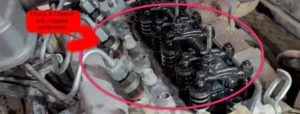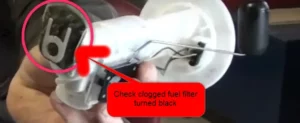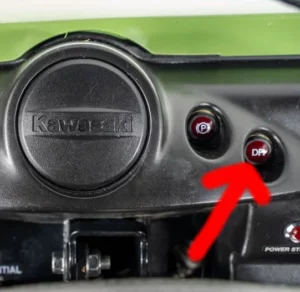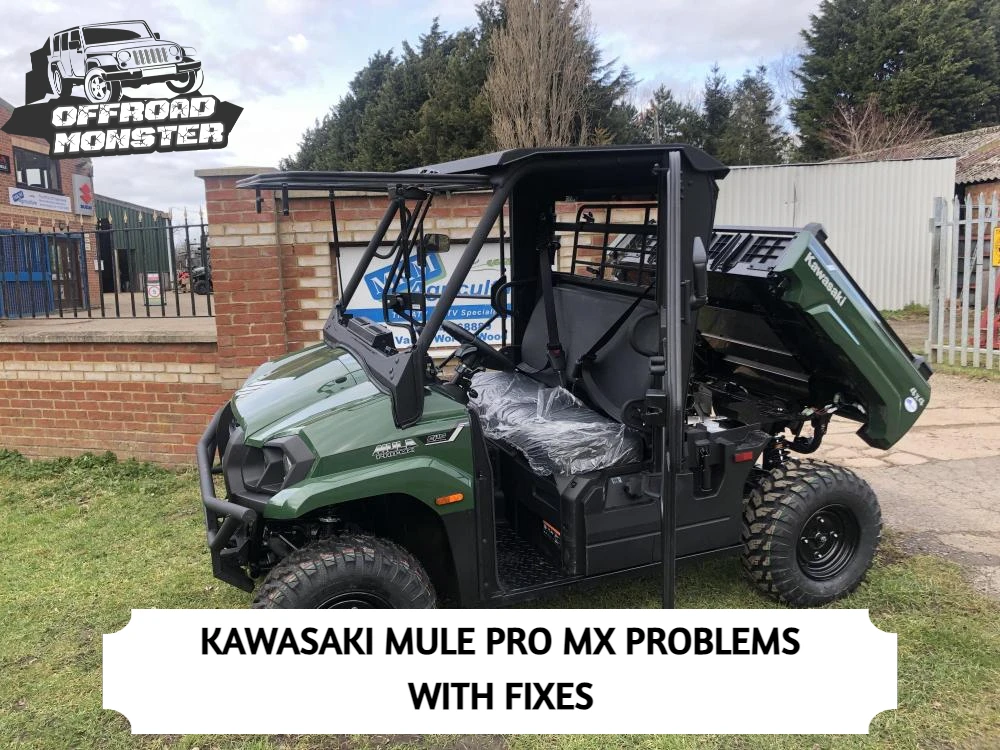Kawasaki Mule 4010 is a popular All Terrain Vehicle (ATV) known for its robust design and exceptional performance. Whether you’re a farmer, a hunter, or just someone who loves to explore the outdoors, this all-terrain vehicle is essential for those who want to get off the beaten path.
However, like any machine, it is also prone to some problems that can hinder its functionality and performance. In this post, we will explore some of the common Kawasaki Mule 4010 problems and provide solutions to help you keep your Kawasaki Mule 4010 running smoothly.
Some of the issues you may encounter with your Kawasaki Mule 4010 include difficulty starting the engine, transmission problems, brake issues, electrical problems, and many more. It is crucial to identify and address these problems as soon as possible to prevent further damage to your Kawasaki Mule 4010.
The Problems And Fixes of Kawasaki Mule 4010:
Let’s look at these issues in detail and with their solutions:
1. Kawasaki Mule 4010 Loss of engine and electrical power Problem:

Riding a Kawasaki 4010 can be an exhilarating experience, but if you’re noticing a gradual decline in power and acceleration, you may be having a problem with your engine and electrical power. In hilly areas, many Kawasaki 4010 riders complain about power loss.
The main cause of this power loss is due to a bad or clogged air filter. The air filter is responsible for regulating the fuel and airflow to the engine, and if it’s clogged or dirty, it can limit the amount of power your engine can generate. A clogged air filter can also cause your engine to overheat, which can lead to further power loss.
The Fix:
To resolve the issue of the engine and electrical power loss in your Kawasaki, check the charging system first. Electrical power can be lost if the charging system is not working properly or if it is not charging. If the battery is not charging, you can check the battery terminals and make sure that they are clean and tight. Make sure the filters or air intakes aren’t clogged with debris or dust.
If the charging system is fine, then the next step is to check for any blockages in the fuel lines or filters. A blockage in one of these areas can result in a loss of power to the engine. Using a fuel line clog detector, you can determine whether there are any blockages in the fuel line. This tool will tell you if there are any blockages and how severe they are. If the clog detector indicates there is a blockage, you can take steps to clean it out.
At least, you may want to check the air intake system to make sure that no blockage is preventing the motor from getting enough air. If there is a blockage, then you can try to loosen it up with a can of compressed air.
2. Kawasaki Mule 4010 Throttle body and Sensor Problem:
The malfunctioning throttle body and sensor in Kawasaki 4010 is a common problem that can be caused by several different issues. According to US EPA regulations, the combustion chamber is exposed to the air intake tubing rather than the atmosphere, which causes this problem. Eventually, oil vapors can cause gumming of the throttle body when they get sucked into the vent system and burned.
There is also an issue that arises with this vehicle regarding the TPS (Throttle Position Sensor) not being available without the throttle. This means that the TPS must be purchased with the throttle or the engine won’t run. The TPS helps to regulate the amount of fuel the engine is getting, so it’s an important component in the overall functioning of the engine.
The Fix:
Fortunately, some simple solutions can help alleviate the problem. The first and simplest solution is to spray throttle body cleaner on the TB and then disconnect the tube from the TB. This will help clean out any dirt or debris that might be stuck in the tube, and it can help restore normal function.
However, if this doesn’t work, then you may need to replace the throttle body and sensor. This can be a difficult job and you’ll need to be sure to get the correct parts. It’s also important to make sure that the replacement parts are compatible with your Kawasaki 4010.
Once you’ve found the correct parts and replaced the throttle body and sensor, the next step is to adjust the idle speed. You’ll need to find the right idle speed for your bike, and then use the idle adjuster to make sure the idle speed is set correctly.
You will also need to ensure that the throttle body is securely connected to the sensor. This can be done with a voltmeter, and you should make sure that the connections are making the right contact.
3. Kawasaki Mule 4010 Gear Shifting Problem:
Many off-road vehicle owners have experienced issues when trying to shift their 4010’s gears, either forward or backward. It can be a frustrating experience, especially when you are out in the middle of nowhere and need to get to your destination.
The truth is, these problems are common for many off-road vehicles. The problem is often due to the way the manufacturer designed the product. The gear shifter may be placed in an awkward position or the shift linkage may be too weak to handle the shifts. This can make it difficult to properly change gears.
The Fix:
Start by giving the engine some boost (80-120 RPMs). This will help the engine to build up some momentum and make it easier to shift. Next, hold down the brake and start your Mule in its current gear. You should be able to shift gears from there.
The clutch pedal should be pushed all the way down before shifting into a higher gear. Whenever you shift up, you will feel resistance as the clutch engages. By now, you should be able to move the shifter easily.
When shifting into a lower gear, be sure to hold down the clutch and then move the gear shifter into the desired gear. You should be able to feel the clutch start to disengage and you should be able to move the gear shifter without too much difficulty.
To ensure a smooth gear shift, make sure to ease the clutch out slowly so that the gear shift is smooth and not too jerky. If you find that the gear shift is too jerky, you may need to make some adjustments to the clutch or the transmission through a professional.
4. Transmission Problem:
When it comes to operating a Kawasaki Mule 4010, one of the most common issues reported by riders is transmission problems that cause excessive noise while shifting gears. This issue is usually caused by a worn clutch, a low transmission fluid level, or even a malfunctioning transmission. But whatever the cause, this problem can be quite a nuisance and it’s important to diagnose and fix it as soon as possible.
The Fix:
If you’re experiencing this problem with your Kawasaki 4010, the first step is to check the clutch. If the clutch is worn, it can cause the transmission to make crackling sounds when shifting gears. The clutch can become worn due to some possible causes, such as frequent heavy use, improper adjustments, or a lack of lubrication. If you suspect your clutch is the culprit, take it to a professional for repair.
The next step is to check the transmission fluid level. If it’s low, it can cause the transmission to make loud cracking noises when shifting gears. Low fluid levels can be caused by a leak in the transmission, so make sure to check the seals and hoses for any signs of wear or damage. Once the leak is fixed and the fluid is topped off, the issue should be resolved.
The issue might also be caused by a malfunctioning transmission if it persists. In this case, you’ll need to take your Kawasaki 4010 to a qualified mechanic for diagnosis and repair.
5. Fuel Pump Problems:

In Kawasaki 4010, excessive debris can interfere with the fuel becoming dirty. Filters that regulate the operation of the motor as well as the fuel pump can become clogged by dirt and debris. When the fuel filters get clogged, the fuel pump will starve for fuel, leading to breakdowns and eventually, death.
Regularly servicing and maintaining the fuel pump is another common cause of fuel pump problems in Kawasaki 4010. Regular maintenance and servicing will ensure that the fuel pump is in good condition and working properly. Otherwise, fuel pump problems can arise due to a lack of lubrication, blockages, and other issues.
The Fix:
To avoid this problem, the fuel filter must be cleaned regularly.
Drain the fuel tank and replace the fuel filter with a new one to clean the fuel filter. Once the filter is replaced, fill the tank with fresh fuel and start the engine. If the engine runs normally, it is an indication that the fuel filter is clean. If not, you will need to repeat the process until the fuel is clean and the engine runs properly.
In addition to cleaning your fuel filter regularly, make sure you check for any other problems that could be causing your fuel pump to malfunction. This includes checking for loose or damaged hoses, worn parts, or damaged fuel lines. If you find any of these issues, they should be fixed before they cause any more damage.
6. Wiring Harness Problems:
A wiring harness is an important system that is designed to keep your ATV’s wiring secured. It consists of cables, wires, and connectors that are responsible for connecting the various components of your ATV’s electrical system. Without a properly functioning wiring harness, your ATV won’t be able to function correctly.
The main connector of the wiring harness in this model has around 18-24 pins. Unfortunately, these pins can become loose over time, leading to many problems. The most common issue caused by loose pins is a disconnected wire. This can result in several electrical issues, such as lights flickering, sudden power loss, or even a dead battery.
Short circuits can also be caused by loose pins. This is where two wires in the wiring harness touch each other, resulting in a surge of electricity which can be damaging to components in the wiring system. This can lead to problems such as melted wires or even burnt-out electrical components.
The Fix:
If you suspect that the wiring harness of your Kawasaki 4010 is having problems, the first step is to inspect the main connector. If it is loose, you will need to tighten it or replace it with a new one.
You should also inspect the other connections in the wiring harness and ensure that they are all secure. If any of the connections are loose, then you should replace the entire wiring harness with a new one.
Furthermore, make sure to regularly inspect and maintain the wiring harness of your Kawasaki 4010. This means checking the main connector and all of the other connections to make sure they are in good condition. By doing this, you can help prevent wiring harness problems from occurring.
7. Faulty Brakes Problem:
If you own a Kawasaki 4010, you may have noticed a loud buzzing or screaming noise when you apply the brakes. If you’re experiencing this sound, it generally indicates it is time for new brake pads.
The sound may be caused by several factors, such as worn brake pads or contaminated brake fluid. Brake pads deteriorate over time, especially in hard-working vehicles. The brake pads become thinner and harder, leading to an increase in friction, which results in a high-pitched squeal.
Furthermore, when brake fluid absorbs moisture, it can reduce the brake system’s efficiency. The moisture can cause dirt and debris to accumulate on the brake pads, which can also create a high-pitched screeching noise.
The Fix:
The brake pads on your Kawasaki 4010 should be replaced if you hear this sound. Make sure to purchase the correct size and type of brake pads for your vehicle, and check for any contamination in the brake fluid.
To install the new brake pads, it is best to take your vehicle to an experienced mechanic. They will be able to remove the old brake pads and properly install the new ones, ensuring that your brakes are working optimally.
8. Kawasaki Mule 4010 DFI Problems:

If you own a Kawasaki Mule 4010, you may have already experienced the dreaded DFI problems. When the Direct Fuel Injection (DFI) light comes on, it is usually accompanied by your Mule 4010 running in idle mode or jerking while driving. The symptoms are indicative of a malfunctioning fuel injection system, which can be caused by a variety of factors.
The most common culprit of DFI problems on the Mule 4010 is the Electronic Control Unit (ECU). The ECU is responsible for monitoring and controlling the fuel injection system, and when it fails, your Mule 4010 will not receive the right amount of fuel. Inefficient fuel consumption can cause the DFI light to flicker on and cause the vehicle to run inefficiently.
Another common issue is a failed ignition coil. A coil of spark is responsible for creating a spark to provide ignition to the fuel and air mixture in the engine. It can cause the DFI light to flicker on, as well as limited or no spark from the coil, resulting in poor engine performance.
The Fix:
Fortunately, most of the problems with the DFI system on the Kawasaki 4010 are relatively easy to solve. In most cases, the problem can be fixed by simply performing the right maintenance on the system. This can include cleaning and/or replacing parts, such as the fuel injectors, which are responsible for providing the correct amount of fuel to the engine.
One of the most common solutions to DFI problems in Kawasaki 4010 is to clean the electrical connections with an electronic cleaner. This helps to clear away dirt and grime that could be blocking the flow of electricity and causing the problem.
9. Under-seat overheating Problem:
When it comes to riding a Kawasaki, safety should always be your top priority. One of the most important safety measures you should take is to make sure that your mule 4010 is well-ventilated. This is because the engine compartment of a mule can become extremely hot during use, and this can be a hazard if not managed properly.
One of the biggest concerns when it comes to mule overheating is something called under-seat overheating. This is when the engine compartment is receiving unrestricted airflow from underneath the floor of the mule. This can cause the Kawasaki to become dangerously hot, and can even burn the rider if not addressed immediately. It can also cause serious damage to the ATV, such as a melted wiring harness or a damaged engine block.
The Fix:
The most important thing you should do is to make sure that there is good airflow around the entire vehicle, especially underneath the seat. Make sure to inspect it regularly to check for any signs of unrestricted airflow, and if you do find any, make sure to take steps to block it off. If you have an enclosed mule, make sure to regularly open the doors to allow for better circulation.
If you do find yourself with an overheated Kawasaki, make sure to take the necessary steps to cool it down. This can include turning off the engine and letting it cool off, or even using an appropriate coolant if needed. You should also make sure to let the vehicle cool off completely before starting it again, and make sure to inspect the ATV regularly for any signs of overheating.
Conclusion for Kawasaki Mule 4010 Problems:
Troubleshooting and repairing the common problems with your Kawasaki Mule 4010 can help to ensure that it runs smoothly and safely.
By understanding the potential causes of these issues, you can better diagnose and solve them when they occur. From faulty ECUs to under-seat overheating, proper maintenance is key in keeping your mule running efficiently and avoiding potential hazards.


